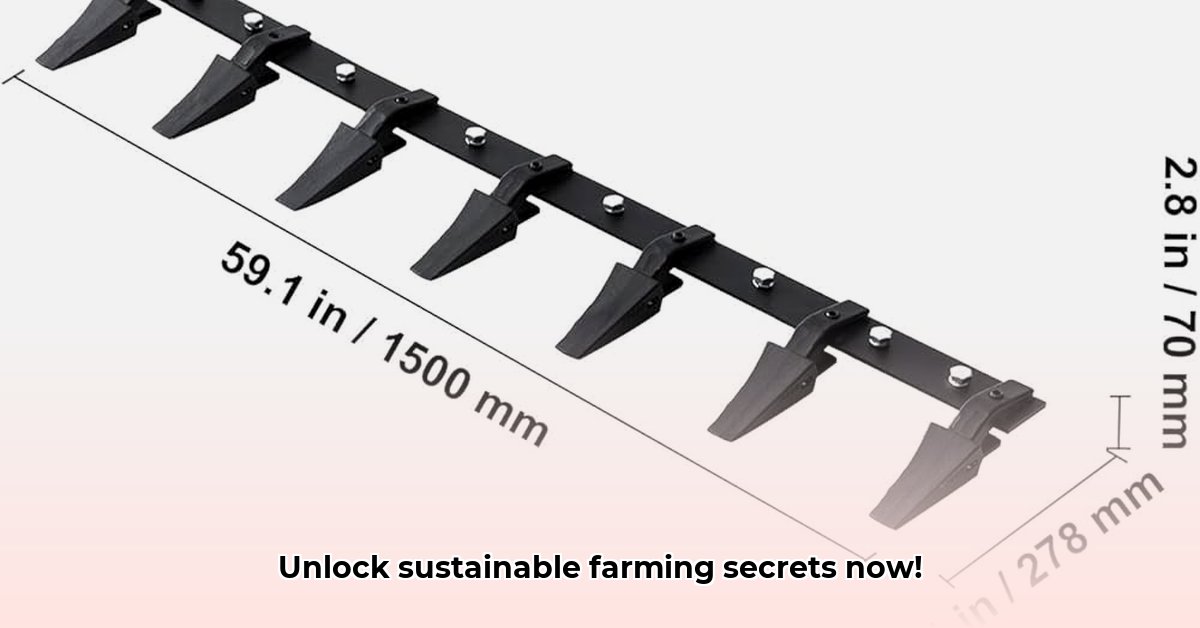
Bucket Teeth Tractor Supply: Your Guide to Sustainable Tillage
Healthy soil is the cornerstone of successful and sustainable agriculture. Reduced tillage practices are crucial for maintaining soil health, and bucket teeth offer a powerful tool to achieve this. This guide provides step-by-step instructions on selecting, installing, and maintaining bucket teeth for your tractor, empowering you to improve soil health and environmental sustainability. For more information on specialized bucket teeth, check out this helpful resource: tractor bucket teeth.
Choosing the Right Bucket Teeth for Your Tractor
Selecting appropriate bucket teeth depends on several factors. Soil type is paramount: heavy clay requires more robust teeth than lighter sandy loam. The size and type of your tractor bucket must also be considered for proper fit and secure attachment. Finally, material choice significantly impacts durability; hardened steel offers superior longevity.
| Soil Type | Recommended Tooth Material | Tooth Size/Configuration | Considerations |
|---|---|---|---|
| Clay | Hardened Steel | Larger, more aggressive | Requires more frequent sharpening. |
| Sandy Loam | High-carbon Steel | Medium, moderately aggressive | Balances digging power and durability. |
| Light Loam | Mild Steel | Smaller, less aggressive | Ideal for minimal soil disturbance. |
Attaching and Using Your Bucket Teeth: A Step-by-Step Guide
Safe and proper installation is crucial. Always consult your tractor's manual.
- Safety First: Ensure your tractor is parked on level ground, brakes engaged, and engine off.
- Clean the Bucket: Remove any debris from the bucket's edge for a secure connection.
- Precise Alignment: Carefully align each tooth with its designated slot.
- Secure Fastening: Use the provided bolts and tighten them firmly according to the manufacturer's torque specifications.
- Test Run: Perform a gentle test run to ensure stability and functionality before commencing work.
Maintaining Your Bucket Teeth for Optimal Performance
Regular maintenance extends the lifespan of your bucket teeth.
- Sharpening: Sharpen dull teeth to maintain effectiveness and prevent excessive wear.
- Inspection: After each use, inspect for cracks, damage, or excessive wear. Replace any damaged teeth immediately.
- Lubrication: Regularly lubricate pins and hinges to reduce friction and wear.
Sustainable Tillage Practices with Bucket Teeth
Bucket teeth promote sustainable tillage by enabling shallow soil working, thus preserving soil structure and minimizing erosion. This also improves moisture retention, ultimately boosting crop yields and potentially reducing irrigation needs. Unlike intensive tillage, which disrupts the soil ecosystem, bucket teeth offer a gentler approach that enhances soil health.
"Reduced tillage methods, such as those utilizing bucket teeth, are vital for improving soil health and promoting sustainable agriculture. They help to retain soil moisture, reduce erosion, and enhance biodiversity." – Dr. Emily Carter, Soil Scientist, University of California, Davis
Troubleshooting Common Issues with Bucket Teeth
- Broken Teeth: Often caused by using inappropriate teeth for the soil type. Ensure proper tooth selection.
- Uneven Tillage: May indicate incorrect installation or damaged teeth. Double-check installation and replace damaged components.
- Premature Wear: Usually due to neglecting maintenance. Adhere to the maintenance schedule diligently.
Conclusion: Investing in Sustainable Farming Practices
Investing in high-quality bucket teeth represents a significant investment in the long-term health of your soil and the sustainability of your farming practices. By promoting soil health and reducing environmental impact, you contribute to a more profitable and ecologically responsible agricultural operation. Staying informed about the latest research in sustainable tillage practices will enhance your success.
How to Choose the Best Reduced Tillage Practices for Diverse Soil Types
Key Takeaways:
- Reduced tillage offers significant environmental and economic advantages over conventional methods.
- Soil type, climate, and crop rotation heavily influence the choice of reduced tillage practice.
- Effective weed and residue management are crucial for successful reduced tillage.
- A phased approach minimizes risks and ensures smoother adaptation.
Choosing the right reduced tillage method is critical for sustainable farming. This requires a deep understanding of your soil type and climate. Clay soils, for instance, are prone to compaction if worked when wet, while sandy soils may need different techniques to maintain moisture.
Understanding Your Soil
Before selecting a tillage method, thorough soil testing is essential. Determine your soil type (sandy, silty, clayey, or a mix), texture, structure, and organic matter content. This information is crucial for choosing the appropriate tillage practice and managing its associated challenges.
Selecting the Right Tillage Technique
Various reduced tillage methods exist. No-till farming leaves all crop residue on the surface, benefiting erosion control and soil health, but can increase weed pressure. Reduced tillage methods include strip-till (tilling only narrow strips), vertical tillage (breaking compacted soil without inversion), and chisel plowing (deep tillage with minimal soil inversion). The best choice depends on your soil type, climate, and crop goals. A phased approach, starting with a less drastic method and gradually transitioning, is often advisable.
The Role of Bucket Teeth in Sustainable Farming
Bucket teeth, used in conjunction with other reduced tillage practices, can effectively manage crop residue, aerate compacted soil, and control weeds. However, selecting the correct tooth material (hardened steel or carbide-tipped, depending on soil abrasiveness) and size/configuration is crucial for optimal performance.
Transitioning to Reduced Tillage
Shifting from conventional to reduced tillage requires planning. Start with small test plots to assess your progress and make necessary adjustments. Continuous monitoring of soil health and yield is critical for optimizing your chosen technique. This is a journey of refinement, not a quick fix. Remember to consider the long-term benefits for both your farm and the environment.